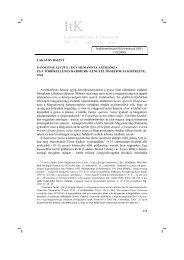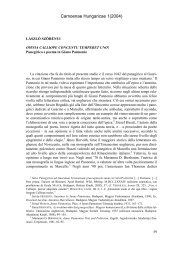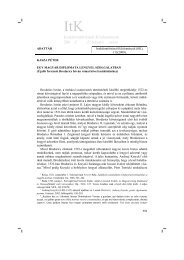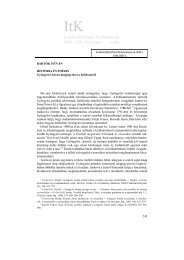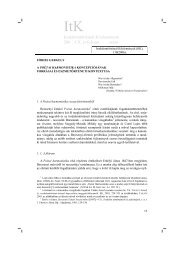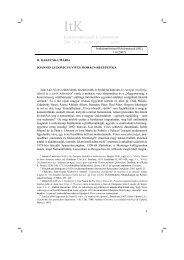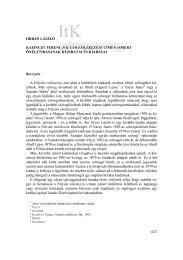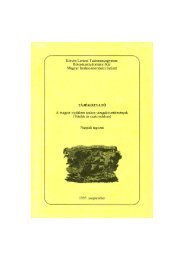Camoenae Hungaricae 3(2006) - Irodalomtörténeti Közlemények
Camoenae Hungaricae 3(2006) - Irodalomtörténeti Közlemények
Camoenae Hungaricae 3(2006) - Irodalomtörténeti Közlemények
You also want an ePaper? Increase the reach of your titles
YUMPU automatically turns print PDFs into web optimized ePapers that Google loves.
<strong>Camoenae</strong> <strong>Hungaricae</strong> 3(<strong>2006</strong>)<br />
Serbian dynasties, along with the Hungarian houses of rulers and the Transylvanian<br />
princes. The title—Monarchia Ungarica in sua regna, principatus et ducatus divisa,<br />
nimirum: Hungariam veram, Bosnam, Serviam, Croatiam, Sclavoniam, Erzegovinam,<br />
Moldaviam, Valachiam, Transylvaniam, Banatum Temesvariensem, Bulgariam—promises<br />
more that can be squeezed into 180 pages, but together with the previous(ly discussed)<br />
volume, we do have a monograph’s worth of descriptions of the Central European<br />
region. To avoid misunderstandings, Marsili wrote, “This treatise, after combined<br />
with the treatise on Mysia, is to be printed.” 41 The two volumes, 108 and 28, combine to<br />
form a basic text which can be regarded as the seed from which his later scientific and<br />
political works sprung forth or rather some pliable material that will assume not only<br />
different shapes but different ideological cores as well, depending on what actual political<br />
situation the author wanted to adjust it to.<br />
The former work, the Descrittione, looks at the region from a bird’s eye view and describes<br />
the potential border areas of the Habsburg state from the Adriatic to the Black<br />
Sea. What he had in mind was a mountainous border region easily defensible against the<br />
Turks and toward the end of the treatise, he also devotes space to the defence of territories<br />
from the direction of Ukraine and Tartar-held lands. 42 The bogging down of military<br />
campaigns in the early 1690s and temporary successes by the Turks resulted in the shifting<br />
of Marsili’s attention to the Kingdom of Hungary proper. Of the Balkan countries,<br />
which he formerly regarded from a broad, imperial perspective, he retained interest only<br />
in those which in the past had some sort of legal connection with the Hungarian Crown,<br />
since historic claims could become bargaining chips in potential peace negotiations. As<br />
the text itself reveals, the Monarchia Ungarica is a product of the months immediately<br />
following the peace treaty of Karlowitz 43 and this is apparent from its hasty wording and<br />
the insertion of genealogies supplanting country descriptions and histories. Marsili turned<br />
the originally Italian text into Latin, since, as he said, he no longer targeted a select circle<br />
of statesmen as he did with the first work, but a wider, erudite, European audience, interested<br />
not only in the politics of the region but in other issues as well. Even though the<br />
two parts of the planned work were realized in two separate periods and in two different<br />
languages, they are very closely related—at least Marsili himself thought they could be<br />
amalgamated. It is probable that he intended to preface the first plan with a historical<br />
sketch of the origins and features of the Hungarian “rebellions”—there is an Italianlanguage<br />
treatment of the subject among his papers entitled Memorie e introduzione<br />
rio…” BUB Ms 28, without pagination (Ad tabulam genealogicam regum Nemaniorum apodixis). On the<br />
collection of the monastery manuscripts, cf. Lettera di prefazione, 184.<br />
41 “Questo trattato unito al Volume del Trattato delle Misie è compito per stamparsi”. BUB Ms 28.<br />
42 Endre Veress had earlier pointed out that the two works belonged together (VERESS 1906, op. cit., 36–<br />
37). Brief summaries by STOYE 1994, op. cit., 161–162, and by DEÁK 2004, op. cit., 32–33, 37.<br />
43 Marsili drew a sketch of the headstone of Lawrence, son of the Bosnian King Nicholas, appointed by<br />
Mathias, which he found in Ilok (Újlak) in the Syrmia region in the course of his survey of the borders in the<br />
aftermath of the Karlowitz peace treaty. See in BUB Ms 28, without pagination (Ad tabulam genealogicam<br />
regum Bosnae apodixis).<br />
123



